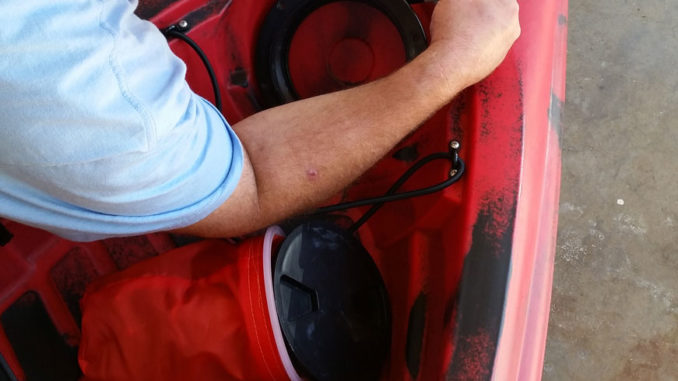
Whistle, PFD, trolley anchor, dry bag are musts
The kings and Spanish mackerel were hitting strong over the past week, likely the last good run for the year. The ocean was tame, making for an easy surf entry and paddle on the kayak.
Several hundred yards offshore, the boats began to pile up. Some were casting nets in search of bait, while others were already trolling. Ahead, one boat’s course carried it dangerously close to where an angler was floating with a kayak. With the boater looking towards the stern at his lines and the waves blocking the view of the low-riding kayak, the situation became dangerous quickly.
This fictional scenario happens quite often, actually. The targeted gamefish may change, as well as the location, but a kayak or canoe sharing a body of water with motorboats is the same as a bicyclist riding on a four-lane highway. But there are other dangers, and with proper safety measures, the water can be shared in a safe manner.
Ask any kayak angler who ventures into saltwater, and he or she will tell you quickly to make sure you have a flag waving. As a kayak or canoe flows up and down the waves, the low profile can quickly disappear from the sight of another vessel only a few yards away. A brightly colored flag helps keep the kayak visible at greater distances.
If you are on the water in a kayak or a canoe, you always have to be aware of your surroundings. When a boat gets a little too close and you realize a change in direction is in order, it is awfully hard to make a quick move with a paddle. You have to get the other boat’s attention. Unlike a car, we do not always have a horn at hand. Noise though, is easily the quickest way to get someone to look your way.
A person’s voice can be drowned out by the sound of a motor, as the frequencies are too close together. A whistle, on the other hand, is high-pitched and can pierce through other loud noises. A Fox 40 whistle is ideal. It has a pea-less design that prevents a malfunction if water gets inside. This is the same whistle basketball and football referees use to get players’ attention, even with a loud fan base screaming at the action. It can easily be clipped to your personal flotation device so it is at the ready at all times.
That brings up another absolute necessity. The PFD is the equivalent of a motorcyclist’s helmet. Eventually, you will end up in the water if you spend enough time in a kayak. It is inevitable. It is possible even if you realize you are about to take a splash, you may not realize what will follow. A few years ago, I was paddling along a section of the Neuse River during a heavy flow. As one of my fishing rods hung on a low-hanging branch, it turned the boat around sideways. The current sweeping along under the boat, along with the rod holding the boat from the top, caused it to capsize. I realized what was happening; I did not realize it would dump a marine battery that provided power for a trolling motor into my ribs.
The PFD allowed me to regain my composure, even through the intense pain of a newly broken rib, without having to focus on keeping my head above water. Remember also, while it is not law to wear a PFD, just having it in the kayak does not mean you are safe, as my experience proves.
If you use any type of anchor and tie it to a cleat, the same thing can happen as it did when I went down. Rather than using a cleat to tie off an anchor, a trolley anchoring system works better and is safer. Usually consisting of a ring in which the anchor is attached, the ring can be moved from bow to stern by a series of pulleys mounted to the kayak. If you feel the kayak starting to be pulled into a capsizing position, you can quickly either unclip the anchor or grab the draw rope and move the anchor ring to the front or rear. This allows it to point into the flow of water rather than perpendicular to it.
Even then, a knife mounted near the seat or attached to your PFD can come into quick use. Grab the anchor rope or trolley line and cut it. Of course, the knife works on snagged fishing line and a number of other occurrences you may encounter.
Last, keep some type of dry storage for belongings such as your wallet, identification, fishing and hunting licenses, cell phone and other essentials. You can use a foldable dry bag or a cat bag with a sealed hatch. Even if you capsize, your items will stay dry and you know where they are located.
I now use the hatch-style cat bag. I watched as my dry bag floated downriver when I took a tumble, and it was not easy to paddle to catch up to it with a broken rib. But I was able to live to paddle again.



Be the first to comment